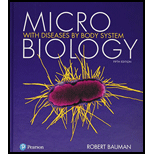
Microbiology with Diseases by Body System (5th Edition)
5th Edition
ISBN: 9780134477206
Author: Robert W. Bauman Ph.D.
Publisher: PEARSON
expand_more
expand_more
format_list_bulleted
Question
Chapter 10, Problem 6SA
Summary Introduction
To answer:
The preventive measures to inhibit the growth of the virulent strain. Pathogens (resistant strains) are a concern to the general health of a population.
Introduction:
The microbial cells become more resistant against the antimicrobials. It forms enzyme which make the drug to act slowly or prevent the drug entry. The drug is modified (target), so that the drug is unable to bind efficiently. The drug
Expert Solution & Answer
Want to see the full answer?
Check out a sample textbook solution
Students have asked these similar questions
Based on your results from the Mannitol Salt Agar (MSA) media, which of your bacteria were mannitol fermenters and which were not mannitol fermenters?
help tutor please
Q8. A researcher wants to study the effectiveness of a pill intended to reduce stomach heartburn in pregnant
women. The researcher chooses randomly 400 women to participate in this experiment for 9 months of their
pregnancy period. They all need to have the same diet. The researcher designs two groups of 200 participants:
One group take the real medication intended to reduce heartburn, while the other group take placebo
medication. In this study what are:
Independent variable:
Dependent variable:
Control variable:
Experimental group: "
Control group:
If the participants do not know who is consuming the real pills and who is consuming the sugar pills.
This study is
It happens that 40% of the participants do not find the treatment helpful and drop out after 6 months.
The researcher throws out the data from subjects that drop out. What type of bias is there in this study?
If the company who makes the medication funds this research, what type of bias might exist in this
research work?
Chapter 10 Solutions
Microbiology with Diseases by Body System (5th Edition)
Ch. 10 - Prob. 1TMWCh. 10 - Some antimicrobial drugs are harmful to humans....Ch. 10 - Antibiotic Overkill A young woman was taking...Ch. 10 - Prob. 2CCSCh. 10 - Prob. 3TMWCh. 10 - Why is it incorrect to say that an individual...Ch. 10 - Prob. 1EDCSCh. 10 - Prob. 3CCSCh. 10 - Prob. 1MCCh. 10 - In a Kirby-Bauer susceptibility test, the presence...
Ch. 10 - Prob. 3MCCh. 10 - Prob. 4MCCh. 10 - Cross resistance is _____. a. the deactivation of...Ch. 10 - Prob. 6MCCh. 10 - Prob. 7MCCh. 10 - Prob. 8MCCh. 10 - Prob. 9MCCh. 10 - Prob. 10MCCh. 10 - Label each figure below to indicate the class of...Ch. 10 - What specific test for antimicrobial efficacy is...Ch. 10 - What characteristics would an ideal...Ch. 10 - Prob. 2SACh. 10 - Why is the fact that drug Z destroys the NAM...Ch. 10 - Given that both human cells and pathogens...Ch. 10 - Prob. 5SACh. 10 - Prob. 6SACh. 10 - Prob. 7SACh. 10 - Prob. 8SACh. 10 - Compare and contrast the actions of polyenes,...Ch. 10 - Prob. 10SACh. 10 - Prob. 1CTCh. 10 - How does Penicillium escape the effects of the...Ch. 10 - How might a colony of Bacillus licheniformis...Ch. 10 - Fewer than 1 % of known antibiotics have any...Ch. 10 - In an issue of News of the Lepidopterists Society,...Ch. 10 - Even though aminoglycosides such as gentamicin can...Ch. 10 - Prob. 7CTCh. 10 - Prob. 8CTCh. 10 - Why might amphotericin B affect the kidneys more...Ch. 10 - Antiparasitic drugs in the benzimidazole family...Ch. 10 - Prob. 11CTCh. 10 - Scientists have cultured bacteria isolated from...Ch. 10 - Prob. 13CTCh. 10 - Prob. 14CTCh. 10 - Enterococcus faecium is frequently resistant to...Ch. 10 - Prob. 1CM
Knowledge Booster
Learn more about
Need a deep-dive on the concept behind this application? Look no further. Learn more about this topic, biology and related others by exploring similar questions and additional content below.Similar questions
- What is behavioral adaptarrow_forward22. Which of the following mutant proteins is expected to have a dominant negative effect when over- expressed in normal cells? a. mutant PI3-kinase that lacks the SH2 domain but retains the kinase function b. mutant Grb2 protein that cannot bind to RTK c. mutant RTK that lacks the extracellular domain d. mutant PDK that has the PH domain but lost the kinase function e. all of the abovearrow_forwardWhat is the label ?arrow_forward
- Can you described the image? Can you explain the question as well their answer and how to get to an answer to an problem like this?arrow_forwardglg 112 mid unit assignment Identifying melting processesarrow_forwardGive only the mode of inheritance consistent with all three pedigrees and only two reasons that support this, nothing more, (it shouldn't take too long)arrow_forward
- Oarrow_forwardDescribe the principle of homeostasis.arrow_forwardExplain how the hormones of the glands listed below travel around the body to target organs and tissues : Pituitary gland Hypothalamus Thyroid Parathyroid Adrenal Pineal Pancreas(islets of langerhans) Gonads (testes and ovaries) Placentaarrow_forward
arrow_back_ios
SEE MORE QUESTIONS
arrow_forward_ios
Recommended textbooks for you
 Human Heredity: Principles and Issues (MindTap Co...BiologyISBN:9781305251052Author:Michael CummingsPublisher:Cengage Learning
Human Heredity: Principles and Issues (MindTap Co...BiologyISBN:9781305251052Author:Michael CummingsPublisher:Cengage Learning Microbiology for Surgical Technologists (MindTap ...BiologyISBN:9781111306663Author:Margaret Rodriguez, Paul PricePublisher:Cengage LearningHealth Safety And Nutrition F/Young ChildHealth & NutritionISBN:9781305144767Author:MAROTZPublisher:Cengage
Microbiology for Surgical Technologists (MindTap ...BiologyISBN:9781111306663Author:Margaret Rodriguez, Paul PricePublisher:Cengage LearningHealth Safety And Nutrition F/Young ChildHealth & NutritionISBN:9781305144767Author:MAROTZPublisher:Cengage




Human Heredity: Principles and Issues (MindTap Co...
Biology
ISBN:9781305251052
Author:Michael Cummings
Publisher:Cengage Learning

Microbiology for Surgical Technologists (MindTap ...
Biology
ISBN:9781111306663
Author:Margaret Rodriguez, Paul Price
Publisher:Cengage Learning

Health Safety And Nutrition F/Young Child
Health & Nutrition
ISBN:9781305144767
Author:MAROTZ
Publisher:Cengage
Infection Prevention and Control; Author: thecityoftoronto;https://www.youtube.com/watch?v=jx9sRYmBW3Q;License: Standard Youtube License